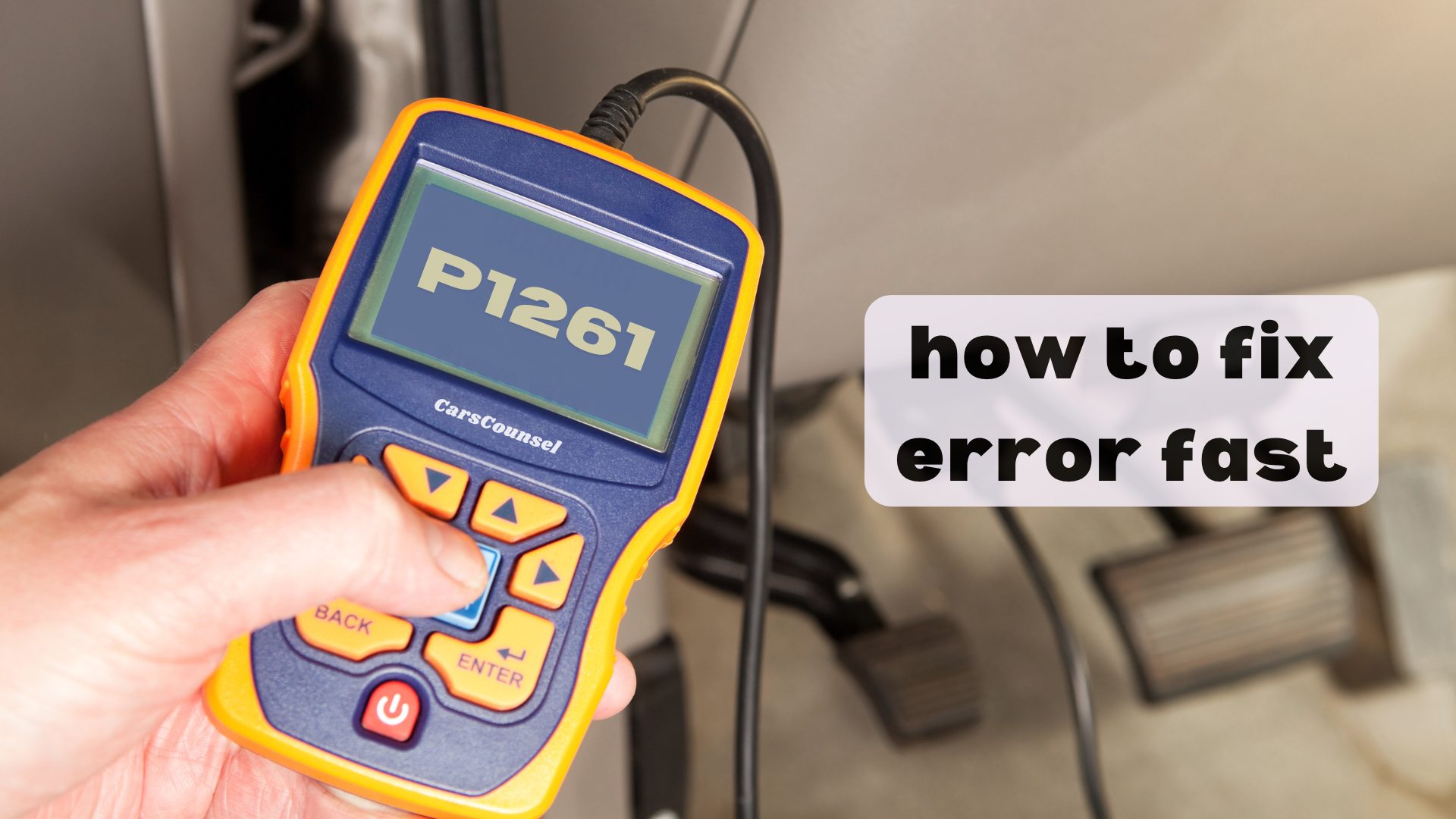You’ve probably heard the phrase “fuel injector issues” thrown around, but did you know that a single faulty electrical connection can bring your entire engine to a grinding halt? That’s exactly what’s happening when your car’s onboard computer spits out a P1261 code, indicating a short in the high to low side circuit of cylinder #1’s fuel injector.
This error code is like a red flag waving in your face, signaling that something’s amiss, but what exactly is going on beneath the surface?

Quick Navigation
Key Takeaways
- The P1261 code indicates a short in the high to low side circuit of cylinder #1’s fuel injector, causing improper fuel delivery and poor engine performance.
- Faulty fuel injector, wiring harness issues, or ECM malfunction can cause the P1261 code, leading to misfires, hesitation, and stalling.
- Symptoms include rough idling, engine misfires, decreased fuel efficiency, and a Check Engine Light on the dashboard.
- Diagnostic steps involve inspecting the wiring harness, testing the fuel injector, and checking electrical connections to identify the root cause.
- Repair steps may include replacing the fuel injector, repairing wiring issues, and resetting the ECM to resolve the P1261 code.
Code P1261 Description and Effects
When the Engine Control Module (ECM) triggers the P1261 code, it indicates a short in the high to low side circuit of cylinder #1 in the engine’s fuel injector.
This means you’re dealing with fuel injector issues, specifically an electrical connection problem between the fuel injector and the ECM. As a result, you can expect improper fuel delivery to cylinder #1, leading to poor engine performance, misfires, and potentially even engine stalling.
If you don’t address this issue, it can cause further damage to engine components and decrease fuel efficiency. You may notice symptoms like engine misfires, hesitation, and stalling, accompanied by a Check Engine Light on your dashboard.
Common Causes of the P1261 Code
What’s behind the P1261 code?
When you see this code, it’s likely due to a faulty fuel injector in cylinder #1, wiring harness issues or shorts in the high to low side circuit, or an ECM malfunction.
You might also be dealing with poor electrical connections or corrosion/damage to connector pins. These electrical issues can cause faulty connections, leading to improper fuel delivery and engine performance problems.
Inspect the wiring harness and connectors for signs of damage or corrosion, and test the fuel injector to verify it’s functioning properly.
Addressing these common causes will help you get to the root of the P1261 code and fix the issue.
Identifying P1261 Code Symptoms
Now that you’ve identified the possible causes of the P1261 code, it’s time to recognize the symptoms that led you to investigate this issue in the first place. You’re likely experiencing some issues with your vehicle’s engine performance, and understanding these symptoms will help you better diagnose the problem.
| Symptom | Description | Impact on Engine Performance |
|---|---|---|
| Rough Idling | Engine struggles to maintain a steady idle | Decreased fuel efficiency, poor engine performance |
| Misfire Symptoms | Engine misfires or hesitation during acceleration | Decreased fuel efficiency, poor engine performance |
| Check Engine Light | Illuminated dashboard light indicating a problem | Warning sign of a more serious issue |
| Decreased Fuel Efficiency | Lower gas mileage than usual | Increased fuel costs, environmental impact |
| Engine Stalling | Engine shuts off while driving | Safety risk, inconvenience |
These symptoms are all indicative of a larger issue with your vehicle’s fuel injector circuit, and addressing them promptly will help prevent further damage.
Diagnostic and Repair Steps
How thoroughly have you inspected your vehicle’s fuel injector circuit?
To diagnose and repair the P1261 code, start by performing a thorough inspection of the wiring harness and connectors for any signs of damage or corrosion.
Test the fuel injector in cylinder #1 to verify it’s functioning properly. Check and repair any faulty electrical connections or wiring issues.
Clear the diagnostic trouble codes and reset the ECM to see if the issue persists. If the problem remains, consider replacing the fuel injector or addressing any underlying ECM issues.
Troubleshooting the Fuel Injector
When inspecting your vehicle’s fuel injector circuit, you likely noticed that the fuel injector in cylinder #1 is a prime suspect in the P1261 code mystery.
As Fuel Injector Failure is a common cause of this code, it’s essential to test the fuel injector to verify it’s functioning properly.
Perform a Fuel Pressure Check to identify any issues with the fuel system. Check the fuel pressure regulator, fuel filter, and fuel pump to confirm they’re working correctly.
If the fuel pressure is low, it may indicate a faulty fuel pump or clogged fuel filter. If the pressure is high, it could be a sign of a faulty fuel pressure regulator.
Wiring Harness Inspection and Repair
With the fuel injector‘s electrical connections in mind, turn your attention to the wiring harness, a maze of wires and connectors that can be prone to damage, corrosion, or wear.
You’ll want to inspect the wiring harness for any signs of wiring damage, such as frayed or pinched wires, corrosion, or overheating. Electrical faults can cause short circuits, leading to the P1261 code.
Check the connectors and pins for corrosion or damage, verifying they’re clean and secure. Look for any signs of water or moisture intrusion, which can accelerate corrosion.
Use a wiring diagram to trace the high to low side circuit, identifying any areas of concern. By thoroughly inspecting and repairing the wiring harness, you can eliminate electrical faults and guarantee proper communication between the fuel injector and ECM.
Resetting the ECM and Clearing Codes
Your scan tool beeps, signaling the end of the diagnostic dance: the P1261 code remains, refusing to disappear.
Now it’s time to reset the Engine Control Module (ECM) and clear the codes. This step is vital, as it allows the ECM to re-learn and adapt to any repairs you’ve made.
Resetting the ECM can also help you identify if the issue is truly resolved or if further troubleshooting is needed. When clearing codes, make sure to follow the manufacturer’s recommended procedure to avoid any potential issues.
Additional Repair Information and Tips
After resetting the ECM and clearing the codes, you’re ready to tackle any additional repairs needed to address the P1261 code.
Now, it’s essential to perform fuel injector cleaning to guarantee proper fuel delivery to cylinder #1. You should also conduct thorough electrical system checks to identify and rectify any wiring harness issues or shorts in the high to low side circuit.
Don’t forget to inspect the connector pins for corrosion or damage. Additionally, check the valve cover wire harness connections, as they can be a common culprit.
More OBD-II Codes
Conclusion
You’ve reached the finish line in diagnosing and repairing the P1261 code. With the faulty fuel injector or wiring harness issues behind you, your engine’s fuel delivery system is now purring like a contented cat. The misfires and stalling are just a distant memory, and your vehicle’s performance is back on track. Remember, a well-maintained engine is a happy engine, and you’re the master mechanic who’s made it all possible.

